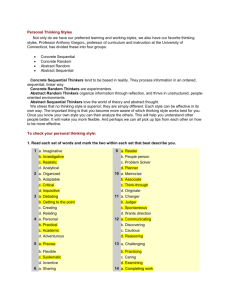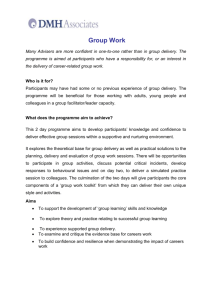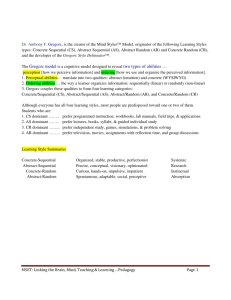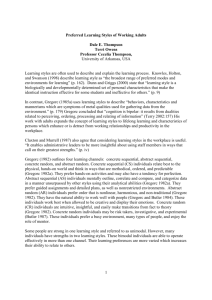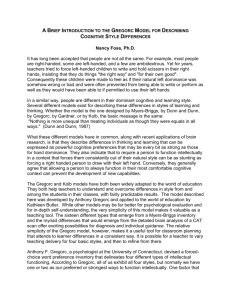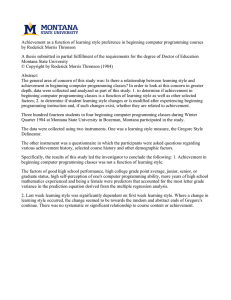Strategies for the Foreign Language Teacher
advertisement
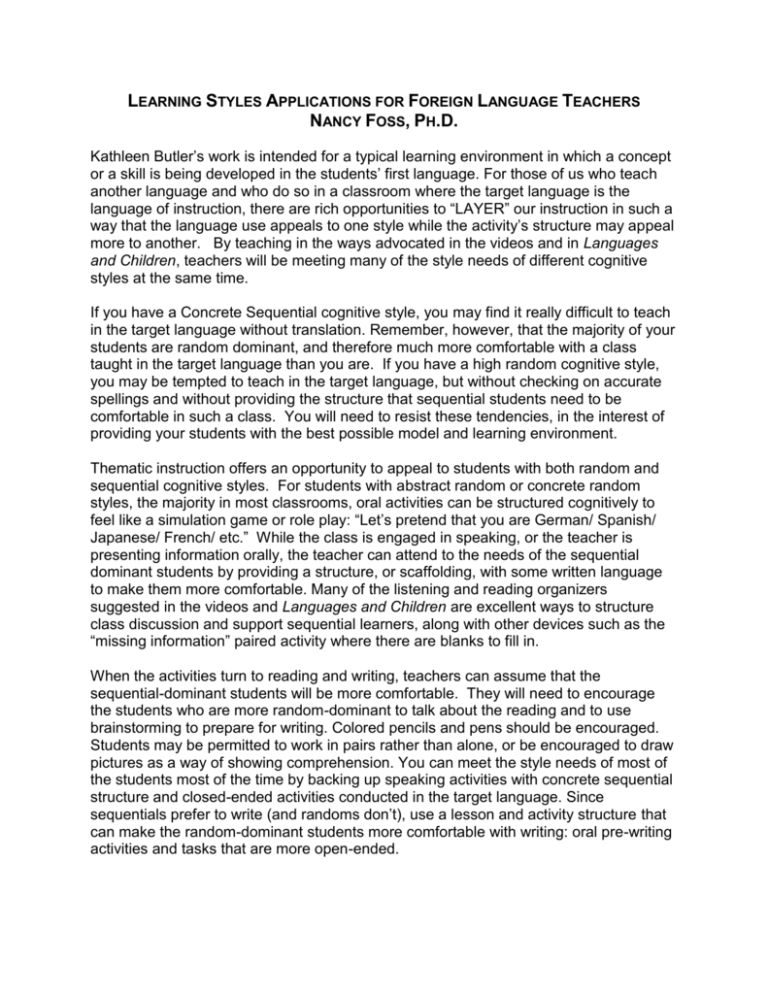
LEARNING STYLES APPLICATIONS FOR FOREIGN LANGUAGE TEACHERS NANCY FOSS, PH.D. Kathleen Butler’s work is intended for a typical learning environment in which a concept or a skill is being developed in the students’ first language. For those of us who teach another language and who do so in a classroom where the target language is the language of instruction, there are rich opportunities to “LAYER” our instruction in such a way that the language use appeals to one style while the activity’s structure may appeal more to another. By teaching in the ways advocated in the videos and in Languages and Children, teachers will be meeting many of the style needs of different cognitive styles at the same time. If you have a Concrete Sequential cognitive style, you may find it really difficult to teach in the target language without translation. Remember, however, that the majority of your students are random dominant, and therefore much more comfortable with a class taught in the target language than you are. If you have a high random cognitive style, you may be tempted to teach in the target language, but without checking on accurate spellings and without providing the structure that sequential students need to be comfortable in such a class. You will need to resist these tendencies, in the interest of providing your students with the best possible model and learning environment. Thematic instruction offers an opportunity to appeal to students with both random and sequential cognitive styles. For students with abstract random or concrete random styles, the majority in most classrooms, oral activities can be structured cognitively to feel like a simulation game or role play: “Let’s pretend that you are German/ Spanish/ Japanese/ French/ etc.” While the class is engaged in speaking, or the teacher is presenting information orally, the teacher can attend to the needs of the sequential dominant students by providing a structure, or scaffolding, with some written language to make them more comfortable. Many of the listening and reading organizers suggested in the videos and Languages and Children are excellent ways to structure class discussion and support sequential learners, along with other devices such as the “missing information” paired activity where there are blanks to fill in. When the activities turn to reading and writing, teachers can assume that the sequential-dominant students will be more comfortable. They will need to encourage the students who are more random-dominant to talk about the reading and to use brainstorming to prepare for writing. Colored pencils and pens should be encouraged. Students may be permitted to work in pairs rather than alone, or be encouraged to draw pictures as a way of showing comprehension. You can meet the style needs of most of the students most of the time by backing up speaking activities with concrete sequential structure and closed-ended activities conducted in the target language. Since sequentials prefer to write (and randoms don’t), use a lesson and activity structure that can make the random-dominant students more comfortable with writing: oral pre-writing activities and tasks that are more open-ended. These methods will, of course, work only if the teacher carefully selects language tasks that are at Krashan”s “i+1” level, just a bit beyond complete comfort level for the students. More difficult tasks need additional scaffolding to support student success. Languages and Children suggests many such devices. Providing for alternation among the four skills is another way to make sure you are meeting style needs; the use of a single content or theme permits reinforcement and support for students as you move in an out of their preferred modes. For example, one can do a pre-reading activity orally while writing a web on the board, then have students read a story, taking notes in a graphic organizer, then ask students to discuss the information in the graphic organizer, and then have them to write something derived from the discussion. Moving from reading to speaking to writing to aural comprehension, etc., can make people less uncomfortable and yet stretch them beyond their style preferences. From a styles perspective, the methods presented in Languages and Children and in the video methods course are an idea way to meet the style needs of almost all students. In this context, the “Magic” words listed above can serve as a valuable way to lower the affective filter of students. Remember that in general the target language environment is more stressful for the Concrete Sequential student than for other styles, so their affective filter may be higher and they may be the most in need of a “Magic Word” or two, or some clear structure to the task. Writing tasks, especially those with short answers that are right or wrong, will likely be stressful for the Concrete Random dominant students unless they can experience them more like a game. Abstract Random dominant students will do better if allowed to use color and to work with another student. To utilize these suggestions in planning thematic units and lessons, choose a progression of activities that build mastery of content while cycling students through different modes of communication, both oral and written: Interpersonal, Interpretive, and Presentational. The cycle of activities can approach the same idea in different ways, appealing to each of the learning styles while building knowledge and language as it progresses. Teachers of German have access to some especially good examples of these methods for teaching foreign languages. German foreign language pedagogy values speaking as much as writing, and the methods and materials developed in Germany demonstrate that appealing to different kinds of cognitive functioning can improve learning. For example, Langenscheidt, the German publisher, has produced several excellent books of paired activities and games for German, Spanish, and French, all available in the U.S.A. The Goethe Institutes provide for style variety by having two teachers of different styles alternate days in a language class, and a large number of their early graded readings involve mystery stories, thus activating the CR cognitive functioning in the brain that helps circumlocution in speech and problem solving in reading.
